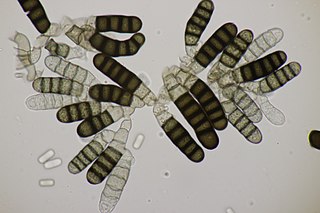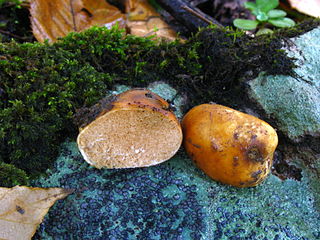
Thielaviopsis is a small genus of fungi in the order Microascales, and family Ceratocystidaceae. The genus includes several important agricultural based pathogens. The most widespread is T. basicola, the causal agent in several root rot diseases of economically important crop species including cotton and a variety of vegetables. In cotton, Thielaviopsis causes root rot, also known as black root rot, which causes necrosis of the roots and stunting of the crop plants.

Torrendiella is a genus of fungi in the family Sclerotiniaceae. It was circumscribed by Jean Louis Émile Boudier and John Torrey in Bull. Soc. Mycol. France vol.27 on page 133 in 1911, with Torrendiella ciliata as the type species. Several species once placed in this genus were transferred to Hymenotorrendiella in 2014.
Cordierites is a genus of fungi in the family Cordieritidaceae.
Horakiella is a genus of fungi within the Sclerodermataceae family that contains the two species H.clelandii and H. watarrkana.
Skepperia is a genus of fungi in the family Thelephoraceae. The genus was described by mycologist Miles Joseph Berkeley in 1857 to contain the type species Skepperia convoluta. The genus was circumscribed by Berkeley in Trans. Linn. Soc. London vol.22 on page 130 in 1857.
Rebentischia is a genus in the Tubeufiaceae family of fungi.

Zelleromyces is a genus of fungi in the family Russulaceae. It was first described by mycologists Rolf Singer and Alexander H. Smith in 1960 to contain hypogeous (underground) fungi with gasteroid fruit bodies that "bleed" latex when they are cut.

Carlo Luigi Spegazzini, in Spanish Carlos Luis Spegazzini, was an Italian-born Argentinian botanist and mycologist.

Octaviania is a genus of truffle-like fungi in the family Boletaceae. The widespread genus is estimated to contain 15 species.
Gustav Heinrich Otth was a Swiss mycologist and military officer. He was the brother of naturalist Carl Adolf Otth (1803-1839).
Vittore Benedetto Antonio Trevisan de Saint-Léon was an Italian botanist who specialized in cryptogamic flora.
Wilhelm (Guillermo) Gustav Franz Herter was a German botanist and mycologist.
Macbrideola is a genus of Amoebozoa in the family Stemonitidaceae. As of 2015, there are 17 species in the genus.
Nomuraea is a genus of fungi in the family Clavicipitaceae.
Harzia acremonioides is a species of seed-borne fungus that occurs in the soil. It has been categorized in the Ceratostomataceae family and under the genus Harzia. The genus Harzia contained up to three accepted species: H. acremonioides, H. verrucose, and H. velatea in 1974. Within the genus Harzia, H. acremonioides is one of the most common species that can be found in all climate regions around the world.
Harzia is a genus of seed-borne fungus that occurs in the soil. It has been categorized in the Ceratostomataceae family. The genus Harzia originally contained three accepted species: Harzia acremonioides, Harzia verrucose, and Harzia velatea. Within the genus Harzia, Harzia acremonioides is one of the most common species that can be found in all climate regions around the world.
Nannizzia is a genus of fungus in the family Arthrodermataceae.
Gibellulopsis is a genus of fungi belonging to the family Plectosphaerellaceae.
Hendersonia is a genus of fungi belonging to the family Phaeosphaeriaceae.





